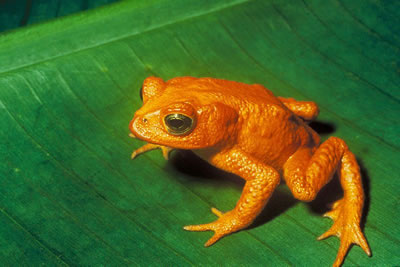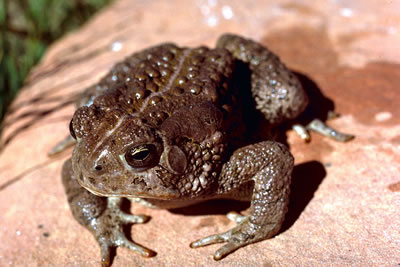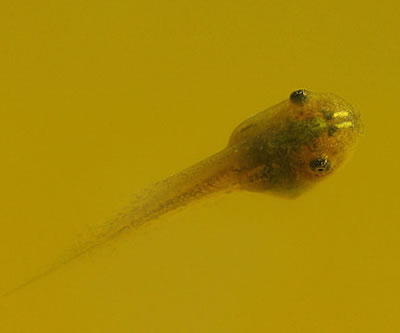Anurans - Frogs and Toads

Facts about creatures
- Home
- Animal Classification
- Animal Habitats
- Amphibians
- Arthropods
- Bats
- Birds
- Carnivorans
- Cetaceans
- Chordates
- Crustaceans
- Dinosaurs
- Diprotodonts
- Elephants
- Fish
- Golden Mole
- Insects
- Lagomorphs
- Mammals
- Mammal Teeth
- Marsupial Mole
- Metamorphosis
- Mollusks
- Primates
- Reptiles
- Rodents
- Ruminants
- Soricomorphans
- Tenrec
- Tetrapods
- Vertebrates
Anurans - Frogs and Toads
Anurans are amphibians that belong to the order Anura, which is made up of frogs and toads.
There are about 3500 species of anuran alive today. They make up the majority of amphibian species.
The smallest living anurans that we know of are the Brazilian gold frog (Brachycephalus didactylus) and the Monte Iberia eleuth (Eleutherodactylus iberia) of Cuba. Both are only about 1/3 of an inch long.
The largest living anuran is the goliath frog (Conraua goliath), which lives in central Africa. It can grow to more than a foot long and weigh as much as 8 pounds.

Anurans can be found on all continents on Earth, except for Antarctica.
Many frogs and toads are native to the tropics, and many species are declining in population because of habitat destruction.
Difference Between Frogs and Toads
Anurans that are adapted to living in drier environments are usually called toads, while anurans that live in wetter environments are often known as frogs.
Frogs usually have smooth, moist skins and long legs, while toads commonly have drier, bumpier skins and short legs.Many frogs have webbed feet. Toads do not have webbed feet.
Although toads resemble each more than they resemble frogs, there is no distinct genetic difference between toads and frogs.
In general, the different species of toads are not more closely related to each other than they are to frogs.

The reason that toads share similar physical characteristics is that they have evolved in similar environments.
The membes of one family of anurans, the Bufonidae, are known as true toads. All of species that belong to the family Bufonidae have toad-like characteristics.
Some zoologists define all anurans as frogs. Therefore, according to their definition, a toad is a kind of frog.
Reproduction
Frogs and toads usually reproduce by means of external fertilization.
Both males and females have cloacas – openings that are used for both excretion and reproduction.
During mating, the male climbs onto the back of the female and wraps his front legs around her. This clasp is known as amplexus, which is a Latin word meaning “embrace”.
The female excretes her eggs from her cloaca. The eggs are released into a body of water, such as a lake, pond, or puddle
The male releases sperm from his cloaca. This sperm is sprayed over the eggs.
A female frog will release her eggs in a large, gelatinous clump.
Toad eggs are excreted in the form of a long string.
A female anuran can lay thousands of eggs at a time.
The larvae that hatch from these eggs are known as tadpoles.

Tadpoles
When a tadpole hatches, it has no eyelids, teeth, legs or lungs.
It moves by swimming, using fins and a long, flat tail to push itself through the water.
A tadpole’s diet is mostly herbivorous. It eats mostly algae and other types of plant matter.
Tadpoles may also eat insects, small fish and other tadpoles.
The tadpole has a large, coiled intestine in which it digests its mostly vegetarian diet.
Like all amphibians, anurans undergo metamorphosis, in which their bodies are transformed from a juvenile form to a completely different adult form.
In a few anuran species, the entire tadpole stage takes place inside the egg. When the anuran hatches, it looks like a small adult frog or toad and is known as a froglet or toadlet.
Some anurans do not lay eggs. They give birth to live young.
Animals that lay eggs are oviparous. Animals that give birth to live young are viviparous.
Sometimes, species in which the female keeps the eggs in her body and gives birth to live young, but does not have a placenta, are said to be ovoviviparous.
Marsupial Frogs
Some frogs are known as marsupial frogs because their eggs, or their young, develop in a pouch that is known as a brood pouch.
The name “marsupial” comes from the Latin word for “pouch”. It is most commonly used to describe a group of mammals that spend part of their early lives living in a pouch.
In some species of marsupial tree frog that live in Central and South America, the female has a brood pouch on her back.
After the female lays her eggs in leaf litter, the male picks them up and puts them in her pouch.
The male then fertilizes the eggs within the pouch, where they will remain until they hatch.
The female Australian marsupial frog (Assa darlingtoni) lays her eggs in leaf litter, and the male fertilizes them there.
The male has a pouch on each of his hips.
After the eggs hatch, the male places as many tadpoles as he can inside his pouches, where they are kept moist. He does not take all of the tadpoles.
The tadpoles undergo metamorphosis when they are still inside the pouch. By the time they emerge from the pouch, they have already become small frogs (froglets).
The Australian marsupial frog is sometimes known as the hip-pocket frog.
Adults
During metamorphosis, tadpoles grow lungs and legs. They lose their gills and their tails.
The name “Anura” is Greek for “without a tail.”
Adult frogs and toads look very different from tadpoles.
In addition to having legs but no tails, adult anurans have short bodies with short spinal columns.
They have long hind legs that help them to jump.
Anurans are known for being exceptional jumpers. Some frogs can jump twenty times the length of their own bodies.
Some frogs also use their long hind legs to help them swim.
Many frogs have webbed, or partially webbed, feet.
Tree frogs, or arboreal frogs, have pads on their toes that help them hold on to vertical services, such as tree trunks.
Some frogs, known as flying frogs, can glide with the help of webbing between their toes and skin flaps on their arms and legs.
Head
Anurans have eyes and nostrils that are high on their heads. They can keep their eyes and nostrils above water when they are swimming.
The eyes of frog and toads stick out.
Anurans use their protruding eyes to help them swallow food.
When an anuran swallows, its eyes move inside its head. The eyes push the food down the anuran’s throat.
An anuran has upper and lower eyelids, as well as a third, translucent eyelid that is known as a nictitating membrane.
The nictitating membrane protects the anuran’s eyes while allowing the anuran to see at the same time. It protects a frog’s eyes from water when the frog is swimming.
An anuran has an organ known as a tympanum on each side of its head. The tympanum is used for hearing. Sometimes, the tympanum is covered by skin.
Adult anurans have no teeth in their lower jaws. Some species have teeth in their upper jaws and some have no teeth at all.
Those anurans that do have teeth use them for grabbing and holding on to prey.
Diet
While tadpoles are mostly herbivores, adult frogs and toads are carnivores.
They mostly eat arthropods, snails, slugs and worms.
During metamorphosis, the intestines of anurans shorten.
This is because carnivores require shorter intestinal tracts than herbivores.
Respiration
Like all amphibians, frogs and toads breathe through their skin as well as through their lungs, through a process known as cutaneous respiration.
Although an anuran has lungs, the lungs are small and by themselves do not provide enough oxygen for the anuran to survive.
Therefore, anurans depend upon the ability to breathe through their skins.
Anurans also “drink” by absorbing water through their skins.
An anuran’s skin must remain moist so that liquids and gases can easily pass in and out.
Lungless Anuran
The only lungless anuran ever to have been discovered is the Bornean flat-headed frog (Barbourula kalimantanensis), also known as the Kalimantan jungle toad.
It was first identified in 1978, but biologists didn’t learn that it had no lungs until a specimen was dissected in 2008.
Bornean flat-headed frogs are flatter than other anurans. This means that they have larger surface areas, so they can get more oxygen when breathing through their skins.
They live in quickly flowing rivers in Borneo.
If a Bornean flat-headed frog had lungs that were filled with air, it might become so light that it would be swept away, so it is advantageous for it to use only its skin for respiration.
The Bornean flat-headed frog is an endangered species.